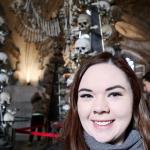Support
During my semester abroad in Prague, Czech Republic, I was able to visit sights related to death and how it was treated within a community in Central Europe, more specifically in the cities of Vienna, Austria; Kutná Hora and Prague, Czech Republic. Within these cities I was able to visit places where the culture of death would be prominent and where I would be able to observe funerary practices and how the dead were treated.
In Vienna, I visited the Stephandom Crypt, Habsburg Imperial Crypt, Cemetery of the Nameless, and the Vienna Crime Museum. The Stephandom Crypt and Habsburg Imperial Crypt were very different in the burial process. The Stephansdom Crypt is home to many people of varying social ranking. There were coffins containing remains of high ranking clergyman in addition to large piles of bones composed of lower-class individuals. The Habsburg Imperial Crypt solely houses the descendants of the Habsburg Royal Family in ornate coffins. While in Vienna, I also visited Cemetery of the Nameless. This is a cemetery that was founded due to the need of a burial place for unidentified individuals who were victims of drowning in the Danube who were washed ashore. This cemetery features grave markers that are all identical to create unity of the group. The last place I visited in Vienna was the Vienna Crime Museum. This was a museum dedicated to the history of crime within Austria and included details about significant crimes from the past. Not only did this museum provide a historical aspect on crime but had examples of how past murder victims’ identity was preserved through the use of death masks. In Vienna, I was able to see many different ways individuals were treated after death and how they differed even within one city.
One day, I took the hour long train ride from Prague to Kutná Hora, Czech Republic. Here I visited the famous Sedlec Ossuary. The Sedlec Ossuary is unique because of how it uses skeletal remains to decorate the chapel. One key feature to this ossuary is the owner’s family crest that is created entirely out of bone. These bones are from the estimated 40,000-70,000 individuals who were victims of the plague that wanted to be buried on the holy ground of the chapel.
In Prague, the most interesting sight I visited was the Old Jewish Cemetery. This cemetery had a large number of gravestones which were often layered and falling atop of each other. This displayed the lack of spaces the Jewish people had within Prague to bury individuals.
Overall, this grant allowed me to explore more of the culture surrounding death while studying abroad and realize that there are three main factors that determine how an individual is buried in Central Europe. These factors are: religion, socio-economic status, and government structure. This project helped me bring what I have learned inside the classroom as an anthropology major into a more hands-on context. This project broadened my knowledge of how different cultures treat the dead which will help me in the future as I plan to enter a graduate program in the field of bioarchaeology after graduating from St. Lawrence.
